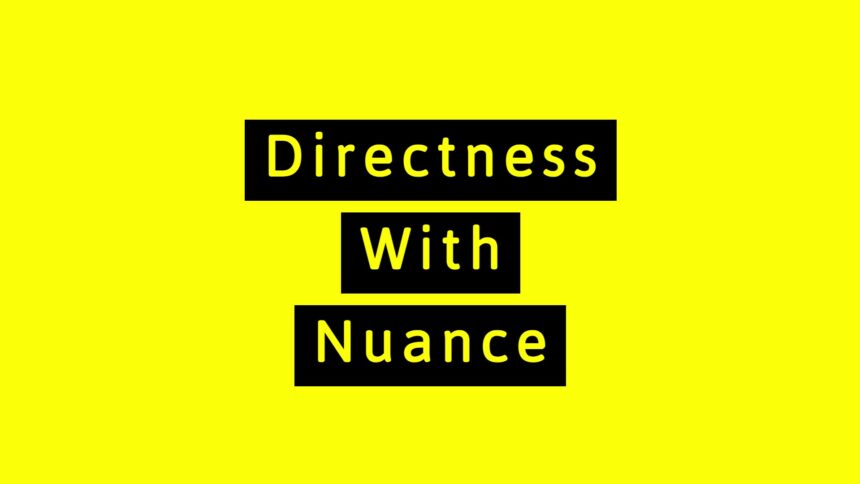In today’s fast-paced and highly connected world, communication skills are more crucial than ever. Among the various techniques to improve communication, mastering “directness with nuance” stands out as a powerful approach. This method combines the clarity of direct communication with the subtlety of nuanced expression, allowing for effective and empathetic interactions. In this article, we will explore the concept of directness with nuance, explore its benefits, and provide practical tips on practicing it effectively.
Understanding Directness With Nuance
Directness in communication means expressing your thoughts clearly and straightforwardly. It avoids ambiguity and ensures that the message is easily understood. Direct communication is often valued for its efficiency and honesty, as it eliminates the need for interpretation and miscommunication.
Nuance, however, involves adding layers of subtlety and depth to your expression. It recognizes that issues and emotions are rarely black and white and that different perspectives can enrich a conversation. Nuanced communication helps convey empathy, respect, and understanding, making the message more sensitive and considerate.
Directness with nuance is about balancing these two elements. It means being clear and straightforward while also being mindful of the subtleties involved in the conversation. This approach ensures that you communicate effectively without disregarding the complexity of human emotions and relationships.
The Benefits of Directness With Nuance
- Enhanced Clarity and Understanding: By being direct, you ensure your message is unambiguous. It helps reduce misunderstandings and ensures your audience knows exactly what you are trying to convey.
- Greater Empathy and Sensitivity: Incorporating nuance allows you to address emotional and contextual aspects of communication. It shows that considering the recipient’s feelings and perspectives can foster trust and rapport.
- More Effective Problem-Solving: Directness with nuance enables you to address issues head-on while acknowledging the complexities involved. This balanced approach can lead to more effective problem-solving and conflict resolution.
- Improved Relationships: By combining clarity with empathy, you create a communication style that is both respectful and honest. It can lead to more robust and more positive relationships in both personal and professional settings.
How to Practice Directness With Nuance
Practicing directness with nuance requires a thoughtful approach to communication. Here are some strategies to help you master this skill:
- Know Your Message: Before communicating, be clear about what you want to convey. Define the main point you wish to make and ensure it is straightforward. This will serve as the foundation for adding nuance.
- Consider the Context: Assess the context of the conversation. Understand the emotional state, background, and perspective of your audience. This will help you determine how to frame your message with the appropriate level of nuance.
- Use Empathetic Language: When delivering your message, acknowledge the recipient’s feelings and viewpoints. Phrases like “I understand that you might feel…” or “I appreciate your perspective on this matter…” show that you are considering their emotions.
- Balance Directness and Nuance: Aim for a balance where your message remains clear but is delivered with sensitivity. For example, instead of saying, “Your report is not good,” you might say, “I see areas where the report could be improved to better meet our objectives. Let’s discuss how we can enhance it.”
- Be Mindful of Tone and Body Language: Non-verbal cues can significantly impact how your message is received. Ensure that your tone and body language align with the nuance you want to convey. A warm tone and open body language can complement a direct message with empathy.
- Practice Active Listening: Engage in active listening to fully understand the other person’s perspective. This will help you tailor your message with the appropriate level of nuance and respond more thoughtfully.
- Seek Feedback: Ask for feedback from trusted colleagues or friends on your communication style. They can provide insights into how well you balance directness with nuance and suggest areas for improvement.
- Adapt Your Approach: Different situations and individuals may require varying degrees of directness and nuance. Be flexible and adapt your communication style based on the situation’s specific needs.
Examples of Directness With Nuance in Action
- In Professional Settings: When providing feedback to a team member, instead of saying, “Your performance is lacking,” you might say, “I’ve noticed some areas where your performance could improve. Let’s identify specific strategies to address these challenges together.”
- In Personal Relationships: If you need to discuss a sensitive topic with a partner, rather than saying, “You never listen to me,” you could say, “I feel like my concerns are not fully heard sometimes. Can we find a better way to communicate about these issues?”
- In Conflict Resolution: During a disagreement, instead of being confrontational, you might say, “I see that we have different views on this issue. Can we explore each other’s perspectives and find common ground?”
Conclusion
Mastering directness with nuance is a valuable skill that enhances communication effectiveness while maintaining sensitivity and respect. By balancing clarity with empathy, you can build stronger relationships, resolve conflicts more effectively, and create a more positive communication environment. Practice these strategies regularly, and you’ll find that your ability to communicate with both directness and nuance will lead to more successful and harmonious interactions.
By embracing the power of directness with nuance, you improve your communication skills and contribute to more meaningful and productive conversations. This approach helps you convey your message clearly while respecting the complexities of human interactions, ultimately leading to better understanding and stronger connections.




